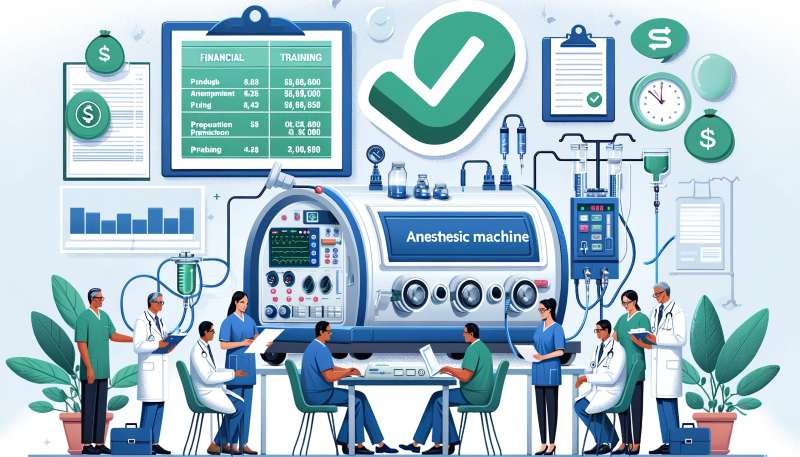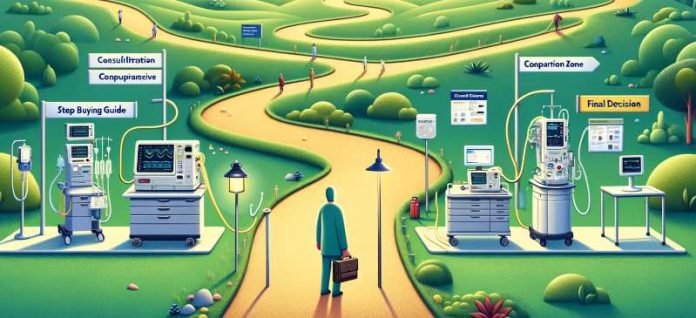Anesthesia machines are essential medical devices used to deliver accurate concentrations of anaesthetic gases and oxygen to patients during surgical procedures. They allow anaesthesia providers to induce and maintain anaesthesia while closely monitoring the patient’s vital signs. Having the right anaesthesia machine is crucial for any surgical facility to ensure safe, effective, and efficient anaesthetic care.
We will provide an overview of anaesthesia machines, factors to consider when purchasing one, and tips for getting the best value. It aims to help medical facilities and practices make informed decisions when investing in this vital medical equipment. With the right information and preparation, you can choose the ideal anaesthesia machine to meet your facility’s specific needs and budget.
Understanding Anesthesia Machine Types

Anaesthesia machines can be broadly categorized into two main types: continuous flow and controlled flow. The key differences between them are:
Continuous Flow Anesthesia Machines
- Utilize constant fresh gas flow to the patient throughout the anaesthetic procedure.
- Allow manual control of gas composition by adjusting vaporizer dial settings.
- Suitable for basic anaesthetic procedures.
- Models include Boyle, Foregger, Ohmeda Modulus, and Datex-Ohmeda Excel 210.
- Advantages: Simple to operate, economical price point.
- Disadvantages: Less precise control and higher gas consumption.
Controlled Flow Anesthesia Machines
- Provide automated control of gas delivery, concentrations, and ventilator settings.
- Allow pre-programmed and patient-specific ventilator settings.
- Equipped with more advanced features and monitoring capabilities.
- Models include GE Aestiva/5 MRI, Draeger Fabius GS Premium, and Mindray A9.
- Advantages: Enhanced ventilation capabilities, reduced waste anaesthesia gas emissions.
- Disadvantages: Complex setup and operations, higher cost.
| Feature | Continuous Flow | Controlled Flow |
|---|---|---|
| Gas Delivery Control | Manual | Automated |
| Fresh Gas Flow | Fixed/Adjustable | Minimal Flow/Low Flow |
| Ventilation Modes | Limited | Advanced options |
| Vital Signs Monitoring | Basic | Comprehensive |
| Safety Features | Standard | Enhanced |
| Ease of Use | Simple | Complex |
| Cost | Economical | Expensive |
When choosing between these two types, consider factors like the types of surgical procedures performed, monitoring needs, budget, and anaesthetic techniques utilized in your facility. Carefully evaluate if the more advanced capabilities of a controlled flow machine will be fully utilized.
Prioritizing Safety Features
Patient safety is the number one priority when administering anaesthesia. Be sure only to purchase anaesthesia machines with the following essential safety features:
- Oxygen failure warning system – alerts users of low oxygen pressure.
- Oxygen flush for rapid denitrogenation and quick increase in FiO2.
- Pressure relief valves prevent barotrauma.
- Disconnect alarm for ventilator circuit disconnects.
- Gas calibration and monitoring abilities.
- Apnea alarm for no breath detected.
Additionally, ensure all components meet manufacturing standards for quality and electrical safety. Carefully inspect the machine for signs of wear or damage prior to purchase. Test all alarms and backup systems to verify proper functioning. Having redundant power sources and oxygen tanks is ideal in case of emergencies or equipment failure.
Evaluating Functionalities and Features

The anaesthesia machine enables anesthesiologists to carry out key functions, including:
- Delivering accurate inhaled anaesthetic agent concentrations.
- Providing positive pressure ventilation.
- Monitoring patient vital signs.
Carefully assess the machine’s capabilities in each of these areas:
Inhaled Anesthetic Delivery
- Number of vaporizers: At least 2 allow agent blending.
- Vaporizer types: Selective and universal vaporizers have pros and cons.
- Vaporizer mounting: Pin indexed helps prevent misconnections.
Ventilation
- Modes: Ensure the machine has volume control, pressure control, SIMV, etc.
- Adjustable parameters: Set tidal volume, rate, PEEP, etc.
- Advanced modes: Consider features like auto-recruitment tools.
Monitoring
- Basic vitals: Pulse oximetry, blood pressure, capnography.
- Advanced monitoring: ETCO2, anaesthetic agent, BIS, neuromuscular transmission.
Ergonomics and Workflow
- Intuitive layout and interface.
- Quick access to key controls.
- Gas pipelines and power outlets are positioned conveniently.
Ease of portability and manoeuvrability are also worth considering if the machine will be moved frequently. Sturdy locking casters enable easy transport. Some facilities may require a mobile machine that can be transported between operating rooms.
| Category | Features to Evaluate |
|---|---|
| Inhaled Agents Delivery | Number of vaporizers, Vaporizer types, Vaporizer mounting, Agent monitoring |
| Ventilation Modes | Available ventilation modes, Adjustable parameters, Advanced ventilation modes |
| Monitoring | Vital signs monitored, Additional integrated monitoring |
| Ergonomics | Layout and interface, Accessibility of controls, Gas/power supply positioning |
| Mobility | Locking casters, Compact/mobile version |
This checklist ensures you assess all necessary functions and select equipment optimized for your workflow and anaesthetic techniques.
Considering Size and Mobility
The anaesthesia machine’s size and mobility impact where it can be situated and how easily it manoeuvres within the operating room. Consider the following:
- Operating room size – Measure the space and layout to ensure the machine can fit comfortably without obstructing movement.
- Storage – Dimension of storage room if the machine needs to be stowed away between uses. Measure door widths as well.
- Portability – Some facilities require frequent transport between ORs. Compact mobile designs allow easy movement.
- Power and gas supplies – The placement of pipelines affects machine positioning. Longer lines allow more flexible locations.
- Transport vehicles – If purchasing for mobile anaesthesia, ensure the machine fits securely in the intended vehicle.
- Accessories – Bulky add-ons like monitors and vaporizers affect overall machine size.
Creating a detailed drawing of the operating room with measurements ensures you select a machine dimensioned to fit your environment and workflow needs.
| Considerations | Details |
|---|---|
| Room dimensions | Measure OR size and layout |
| Doorway clearance | Measure storage room door width |
| Gas/power supply | Measure distance to outlets |
| Mobility needs | Frequent transport? |
| Vehicle dimensions | Measure interior if mobile machine |
| Add-on components | Monitors? Extra vaporizers? |
Budgeting and Financing Options
Anesthesia machines typically range from $15,000 to $50,000, depending on the model and features. Prices for advanced controlled flow machines with comprehensive monitoring abilities tend to be higher. When determining your budget, consider the following:
- Machine purchase cost
- The cost of additional components like vaporizers and monitors
- Expected maintenance and repair costs
- Accessories, consumables, and disposables
- Cost of anaesthesia gas scavenging system if needed
- Warranty and service contract costs
- Shipping, installation, and training costs
Financing options can help pay for equipment purchases over time. Options include:
- Loans – You can get competitive interest rates and predictable monthly payments.
- Leasing – Pay only for the time you use the equipment. It may cost more long-term.
- Rentals – Short term solution but can be expensive over time.
Many vendors offer flexible payment plans – discuss the options to find one that fits your budget and cash flow needs. Avoid agreements with hidden fees or penalties. Have an accountant review financing terms.
| Cost Factors | Details |
|---|---|
| Machine purchase | $15,000 – $50,000 |
| Additional components | Vaporizers, monitors, accessories |
| Maintenance and repairs | Parts replacements, scheduled upkeep |
| Consumables | Anesthesia circuits, masks, gases |
| Additional systems | Gas scavenging |
| Warranty/service plans | Coverage duration, inclusions |
| Shipping and installation | 10-15% of purchase price |
| User training | Plan and budget for training |
Selecting Within Your Budget
Cost often drives anaesthesia machine selection. Here are tips for choosing the right machine within your budget:
- Prioritize safety and ventilation features over advanced capabilities not utilized.
- For smaller budgets, consider continuous flow instead of controlled flow machines.
- Opt for fewer vaporizers, basic monitoring, and smaller display screens to save costs.
- Compare pricing from multiple vendors to get the best value. Negotiate for discounts on multi-unit purchases.
- Consider refurbished equipment; it can save 20-30% over new but has a shorter lifespan.
- Join a group purchasing organization for lower negotiated rates from vendors.
- Choose versatile vaporizers compatible with multiple anaesthetic agents to avoid future upgrade costs.
- Opt for portable units with longer battery life if planning for mobile services.
- Select machines with easily replaceable parts that don’t require frequent, costly service.
- Add advanced features later as budget allows. Monitor compatibility gives future upgradeability.
- Discuss the possibility of equipment trials at your facility before committing to purchase.
With some creative planning, it is possible to find an anaesthesia machine with adequate features to meet your clinical needs at an economical price point. Prioritizing safety and core functionality can help you get the most value within limited budgets.
Ensuring Proper After-Sales Support
The right after-sales service and support plan help maintain the anaesthesia machine optimally. Ensure the vendor provides:
Warranty and Maintenance
- Multi-year warranty covering parts and labour.
- Preventative maintenance schedule per manufacturer guidelines.
- Guaranteed response time for repairs.
- Loaner machines if extended downtime is anticipated.
Training and Education
- Initial machine operation and safety training for staff.
- Clinical applications training.
- Refresher training protocols.
Verify the qualifications of the service engineers and the availability of local support. A response time of 24 hours or less is ideal for urgent issues. Choose a vendor who stocks sufficient spare parts and consumables in your region. Carefully read through service contracts before signing to ensure the scope meets your needs.
| Category | Details to Verify |
|---|---|
| Warranty | Duration, inclusions, exclusions |
| Maintenance | Schedule, response time guarantees |
| Repairs | Guaranteed response time |
| Loaners | Provided if extended downtime? |
| Training | Initial and refresher training are available |
| Local support | Response time, parts/consumable stocks |
| Qualifications | Bios and credentials of service staff |
| Contract terms | Meet your scope needs |
Conclusion
Purchasing the optimal anaesthesia machine requires careful consideration of key factors like machine capabilities, safety, costs, after-sales support, and integration into the clinical environment. Evaluating your procedural requirements and facility infrastructure will guide the selection of the right model. Seeking input from the anaesthesia providers and technical teams is also advised during the buying process. With adequate planning and preparation, you can invest in an anaesthesia machine that reliably delivers anaesthetic care safely and effectively for years to come. Reach out to manufacturers for product demonstrations and pricing discussions, and utilize this guide to make a well-informed equipment choice that best serves your practice’s needs.


